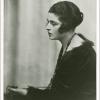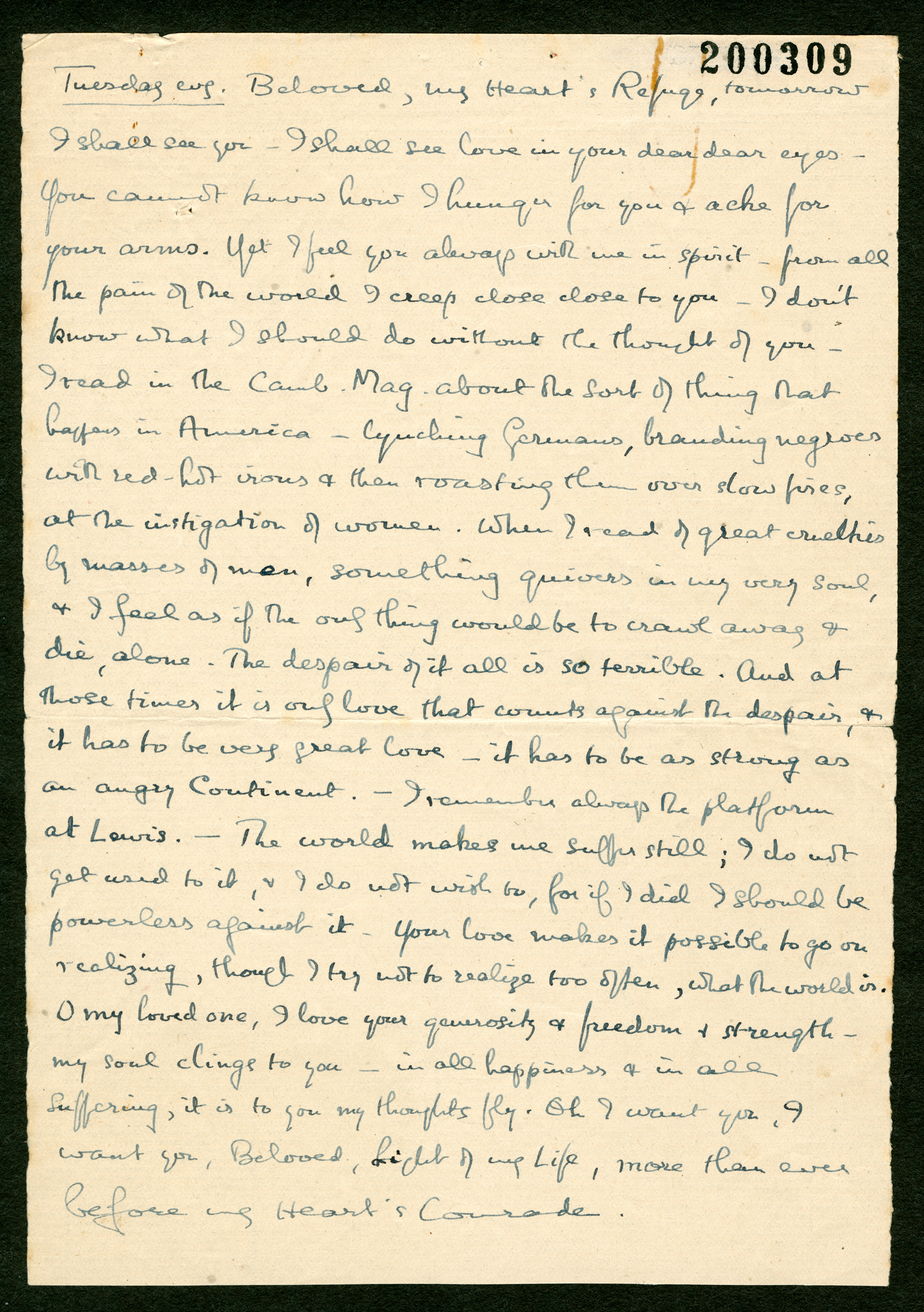
Brixton Letter 17
BR to Constance Malleson
June 11, 1918
- AL
- McMaster
- Edited by
Kenneth Blackwell
Andrew G. Bone
Nicholas Griffin
Sheila Turcon
Cite The Collected Letters of Bertrand Russell, https://russell-letters.mcmaster.ca/brixton-letter-17
BRACERS 19314
<Brixton Prison>1
Tuesday evg.
<11 June 1918>2
Beloved, my Heart’s Refuge, tomorrow I shall see you — I shall see love in your dear dear eyes. You cannot know how I hunger for you and ache for your arms. Yet I feel you always with me in spirit — from all the pain of the world I creep close close to you. I don’t know what I should do without the thought of you. I read in the Camb. Mag.3 about the sort of thing that happens in America — lynching Germans, branding negroes with red-hot irons and then roasting them over slow fires, at the instigation of women. When I read of great cruelties by masses of men, something quivers in my very soul, and I feel as if the only thing would be to crawl away and die, alone. The despair of it all is so terrible. And at those times it is only love that counts against the despair, and it has to be very great love — it has to be as strong as an angry Continent. — I remember always the platform at Lewis.4 — The world makes me suffer still; I do not get used to it, and I do not wish to, for if I did I should be powerless against it. Your love makes it possible to go on realizing, though I try not to realize too often, what the world is. O my loved one, I love your generosity and freedom and strength — my soul clings to you — in all happiness and in all suffering, it is to you my thoughts fly. Oh I want you, I want you, Beloved, Light of my Life, more than ever before my Heart’s Comrade.
- 1
[document] The letter was edited from the unsigned original in BR’s hand in the Malleson papers in the Russell Archives.
- 2
[date] The date assigned to this letter comes from references to The Cambridge Magazine and the Lewes platform.
- 3
read in the Camb. Mag. “An Instance of Mob Law”, Cambridge Magazine 7 (1 June 1918): 765. The article was an excerpt from The New Republic.
- 4
remember always the platform at Lewis BR should have written “Lewes”. He was responding to Colette’s mention of Lewes in her letter of 4 June (BRACERS 113134). He wrote about it in his Autobiography (2: 20). The first mention in their correspondence of this event, which shook up both of them, was in BR’s letter of 7 January 1918 (BRACERS 19266); they reminisced about it several more times in 1918 and even as late as April 1920 (BRACERS 19643). BR and Colette had spent a Sunday walking on the South Downs and were on the train platform at Lewes waiting to return to London. “The station was crowded with soldiers, most of them going back to the Front, almost all of them drunk, half of them accompanied by drunken prostitutes, the other half by wives or sweethearts, all despairing, all reckless, all mad. The harshness and horror of the war world overcame me, but I clung to Colette” (Auto. 2: 26).
Brixton Prison
Located in southwest London Brixton is the capital’s oldest prison. It opened in 1820 as the Surrey House of Correction for minor offenders of both sexes, but became a women-only convict prison in the 1850s. Brixton was a military prison from 1882 until 1898, after which it served as a “local” prison for male offenders sentenced to two years or less, and as London’s main remand centre for those in custody awaiting trial. The prison could hold up to 800 inmates. Originally under local authority jurisdiction, local prisons were transferred to Home Office control in 1878 in an attempt to establish uniform conditions of confinement. These facilities were distinct from “convict” prisons reserved for more serious or repeat offenders sentenced to longer terms of penal servitude.
Heart’s Comrade
Colette first called BR her “heart’s comrade” in her letter of 17 November 1916 (BRACERS 112964). On 9 December (BRACERS 112977), she explained: “I want you as comrade as well as lover.” On 9 April 1917 (BRACERS 19145), he reciprocated the sentiment for the first time. In a letter of 1 January 1918 (BRACERS 19260), BR was so upset with her that he could no longer call her “heart’s comrade”. After their relationship was patched up, he wrote on 16 February 1918 (BRACERS 19290): “I do really feel you now again my Heart’s Comrade.” The last time that BR expressed the sentiment in a letter to her was 26 August 1921 (BRACERS 19742).
Constance Malleson
Lady Constance Malleson (1895–1975), actress and author, was the daughter of Hugh Annesley, 5th Earl Annesley, and his second wife, Priscilla. “Colette” (as she was known to BR) was raised at the family home, Castlewellan Castle, County Down, Northern Ireland. Becoming an actress was an unusual path for a woman of her class. She studied at Tree’s (later the Royal Academy of Dramatic Art), debuting in 1914 with the stage name of Colette O’Niel at the Duke of York’s Theatre, London, in a student production. She married fellow actor Miles Malleson (1888–1969) in 1915 because her family would not allow them to live together. In 1916 Colette met BR through the No-Conscription Fellowship and began a love affair with him that lasted until 1920. The affair was rekindled twice, in 1929 and 1948; they remained friends for the rest of his life. She had a great talent for making and keeping friends. Colette acted in London and the provinces. She toured South Africa in 1928–29 and the Middle East, Greece and Italy in 1932 in Lewis Casson and Sybil Thorndike’s company. She acted in two films, both in 1918, Hindle Wakes and The Admirable Crichton, each now lost. With BR’s encouragement she began a writing career, publishing a short story in The English Review in 1919. She published other short stories as well as hundreds of articles and book reviews. Colette wrote two novels — The Coming Back (1933) and Fear in the Heart (1936) — as well as two autobiographies — After Ten Years (1931) and In the North (1946). She was a fierce defender of Finland, where she had lived before the outbreak of World War II. Letters from her appeared in The Times and The Manchester Guardian. Another of her causes was mental health. She died five years after BR in Lavenham, Suffolk, where she spent her final years. See S. Turcon, “A Bibliography of Constance Malleson”, Russell 32 (2012): 175–90.
